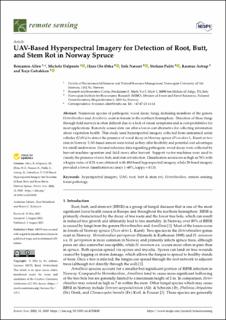| dc.contributor.author | Allen, Benjamin James | |
| dc.contributor.author | Dalponte, Michele | |
| dc.contributor.author | Ørka, Hans Ole | |
| dc.contributor.author | Næsset, Erik | |
| dc.contributor.author | Puliti, Stefano | |
| dc.contributor.author | Astrup, Rasmus Andreas | |
| dc.contributor.author | Gobakken, Terje | |
| dc.date.accessioned | 2023-04-21T09:24:45Z | |
| dc.date.available | 2023-04-21T09:24:45Z | |
| dc.date.created | 2022-09-16T10:45:03Z | |
| dc.date.issued | 2022 | |
| dc.identifier.citation | Remote Sensing. 2022, 14 (15), 1-16. | |
| dc.identifier.issn | 2072-4292 | |
| dc.identifier.uri | https://hdl.handle.net/11250/3064207 | |
| dc.description.abstract | Numerous species of pathogenic wood decay fungi, including members of the genera Heterobasidion and Armillaria, exist in forests in the northern hemisphere. Detection of these fungi through field surveys is often difficult due to a lack of visual symptoms and is cost-prohibitive for most applications. Remotely sensed data can offer a lower-cost alternative for collecting information about vegetation health. This study used hyperspectral imagery collected from unmanned aerial vehicles (UAVs) to detect the presence of wood decay in Norway spruce (Picea abies L. Karst) at two sites in Norway. UAV-based sensors were tested as they offer flexibility and potential cost advantages for small landowners. Ground reference data regarding pathogenic wood decay were collected by harvest machine operators and field crews after harvest. Support vector machines were used to classify the presence of root, butt, and stem rot infection. Classification accuracies as high as 76% with a kappa value of 0.24 were obtained with 490-band hyperspectral imagery, while 29-band imagery provided a lower classification accuracy (~60%, kappa = 0.13). | |
| dc.language.iso | eng | |
| dc.title | UAV-Based Hyperspectral Imagery for Detection of Root, Butt, and Stem Rot in Norway Spruce | |
| dc.title.alternative | UAV-Based Hyperspectral Imagery for Detection of Root, Butt, and Stem Rot in Norway Spruce | |
| dc.type | Peer reviewed | |
| dc.type | Journal article | |
| dc.description.version | publishedVersion | |
| dc.source.pagenumber | 1-16 | |
| dc.source.volume | 14 | |
| dc.source.journal | Remote Sensing | |
| dc.source.issue | 15 | |
| dc.identifier.doi | 10.3390/rs14153830 | |
| dc.identifier.cristin | 2052385 | |
| dc.relation.project | Norges forskningsråd: 281140 | |
| cristin.ispublished | true | |
| cristin.fulltext | original | |
| cristin.qualitycode | 1 | |
